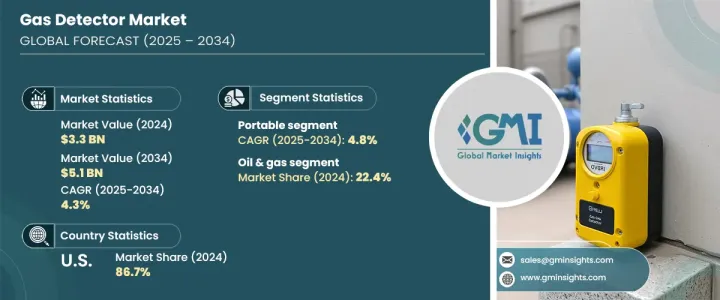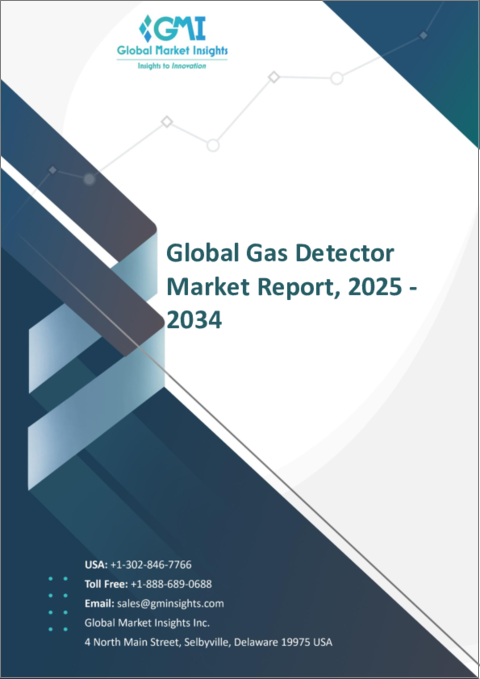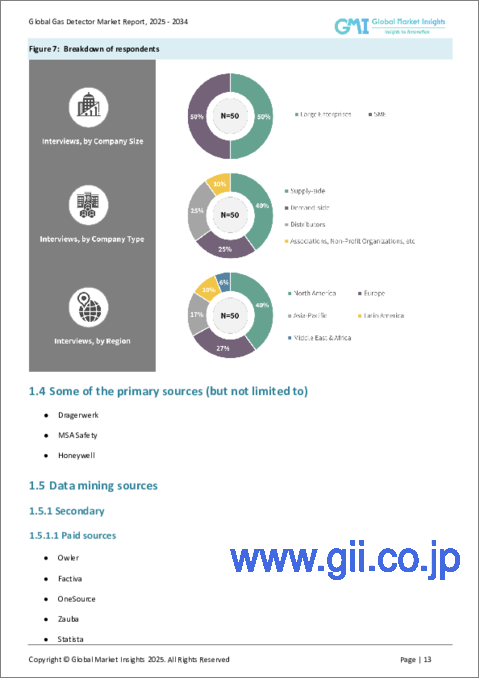|
|
市場調査レポート
商品コード
1685123
ガス検知器市場の機会、成長促進要因、産業動向分析、2025年~2034年の予測Gas Detector Market Opportunity, Growth Drivers, Industry Trend Analysis, and Forecast 2025 - 2034 |
||||||
カスタマイズ可能
|
|||||||
| ガス検知器市場の機会、成長促進要因、産業動向分析、2025年~2034年の予測 |
|
出版日: 2025年01月06日
発行: Global Market Insights Inc.
ページ情報: 英文 150 Pages
納期: 2~3営業日
|
全表示
- 概要
- 目次
ガス検知器の世界市場は、2024年に33億米ドルと評価され、2025年から2034年までのCAGRは4.3%と予測され、安定した成長を遂げようとしています。
ガス検知器は、一酸化炭素、メタン、硫化水素などの特定のガスを検知して空気の質を監視するために使用される重要なツールです。これらの装置は、危険なガス濃度が検出されたときに早期警告を発するように設計されており、さまざまな産業における安全性とコンプライアンスを保証します。産業活動が世界的に増加し続ける中、ガス検知器の需要はより顕著になっています。これらの機器は、作業員や一般市民を保護するだけでなく、環境モニタリングや持続可能な取り組みにも大きく貢献しています。環境汚染を最小限に抑え、厳しい安全規制を満たすことが重視されるようになり、市場の成長はさらに加速しています。

ガス検知器の需要は、環境問題への関心の高まり、職場の安全基準の厳格化、産業ガスがもたらす健康被害への関心の高まりによって大きく左右されます。石油・ガス、石油化学、製造業などの業界では、ガス漏れ、有毒ガス、有害ガスの排出を監視するためにガス検知器が広く使用されています。メタンのような可燃性の高いガスを検知することの重要性から、ガス検知システムはリスク軽減に不可欠なものとなっています。さらに、政府は排出を制限し、環境安全を促進するための厳しい規制を実施するようになっており、産業施設におけるガス検知器の採用をさらに後押ししています。持続可能性と有害汚染物質の削減の推進は、セクターを問わず、高度なガス検知技術の需要に大きな影響を与えています。
| 市場範囲 | |
|---|---|
| 開始年 | 2024 |
| 予測年 | 2025-2034 |
| 開始金額 | 33億米ドル |
| 予測金額 | 51億米ドル |
| CAGR | 4.3% |
市場セグメンテーションでは、ガス検知器産業は固定式と携帯式に分けられます。ポータブルガス検知器分野は堅調な成長が見込まれ、予測期間中のCAGRは4.8%と予測されています。携帯型ガス検知器は、移動性と使いやすさが不可欠な産業で特に評価されています。しかし、石油・ガス、石油化学、製造業など、継続的なリアルタイムのガス監視が必要な業界では、固定式ガス検知器が依然として主流です。これらの固定式システムは、職場の安全性と安全規制の遵守を確保するために不可欠であり、多くの場合、潜在的に危険な状況を作業員に警告するアラームシステムとリンクしています。
エンドユーザー産業の観点から見ると、ガス検知器市場は化学・石油化学、エネルギー・電力、金属・鉱業、石油・ガス、上下水道、住宅・商業ビルなど幅広い分野をカバーしています。中でも石油・ガス産業は重要な消費者であり、2024年の市場シェアは22.4%です。この分野のガス検知器は、可燃性ガスを検知し、潜在的に危険な環境で働く人員の安全を確保するために不可欠です。同様に、化学・石油化学分野では、有毒物質や可燃性物質の漏れを防ぐために継続的なガス監視に大きく依存しており、ガス検知は安全プロトコルの重要な要素となっています。
地域別では、米国のガス検知器市場が2024年の市場シェアで86.7%と圧倒的です。この高い市場シェアは、同国の労働安全衛生局(OSHA)や環境保護庁(EPA)などによる厳しい産業安全規制によるところが大きいです。これらの規制は、特に石油・ガスのようなリスクの高い産業において、安全性と環境保護を確保するためにガス検知器の使用を義務付けています。さらに米国市場では、IoT対応やワイヤレスシステムなど、先進的なガス検知技術の採用が顕著で、産業環境におけるガス監視の効率と効果を高めています。
目次
第1章 調査手法と調査範囲
- 市場範囲と定義
- 基本推定と計算
- 予測計算
- データソース
第2章 エグゼクティブサマリー
第3章 業界洞察
- エコシステム分析
- バリューチェーンに影響を与える要因
- 利益率分析
- ディスラプション
- 将来の展望
- メーカー
- 流通業者
- サプライヤーの状況
- 利益率分析
- 主要ニュース
- 規制状況
- 影響要因
- 促進要因
- 産業用アプリケーションにおけるガス検知器の需要拡大
- 石油・ガス施設におけるガス検知システムの採用増加
- 環境汚染に対する懸念の高まり
- ガス検知器の効率と精度を高める技術的進歩の高まり
- 作業員の健康と安全基準の重視の高まり
- 業界の潜在的リスク&課題
- 高い初期費用とメンテナンス要件
- 技術の複雑さと統合の問題
- 促進要因
- 成長可能性分析
- ポーター分析
- PESTEL分析
第4章 競合情勢
- イントロダクション
- 企業シェア分析
- 競合のポジショニング・マトリックス
- 戦略展望マトリックス
第5章 市場推計・予測:タイプ別、2021年~2034年
- 主要動向
- 電気化学
- 光イオン化
- 赤外線
- 超音波
- その他
第6章 市場推計・予測:設置別、2021年~2034年
- 主要動向
- 固定式
- ポータブル
第7章 市場推計・予測:最終用途産業別、2021年~2034年
- 主要動向
- 化学・石油化学
- エネルギー・電力
- 金属・鉱業
- 石油・ガス
- 水・廃水
- 住宅
- 商業ビル
- その他
第8章 市場推計・予測:地域別、2021年~2034年
- 主要動向
- 北米
- 米国
- カナダ
- 欧州
- 英国
- ドイツ
- フランス
- イタリア
- スペイン
- ロシア
- アジア太平洋
- 中国
- インド
- 日本
- 韓国
- オーストラリア
- ラテンアメリカ
- ブラジル
- メキシコ
- 中東・アフリカ
- 南アフリカ
- サウジアラビア
- アラブ首長国連邦
第9章 企業プロファイル
- ABB
- Aeroqual
- Ametek
- Blackline Safety
- CO2Meter
- Crowcon Detection Instruments
- Draeger
- Emerson
- GAO Tek &GAO Group Inc.
- GasClip Technologies
- Gastec
- GfG Instrumentation
- Honeywell Analytics
- Horiba Ltd.
- Industrial Scientific Corporation
- Ion Science
- MSA Safety
- MSR-Electronic
- New Cosmos Electric Co.
- RKI Instruments
- Sensit Technologies
- Siemens
- Teledyne Technologies
- Thermo Fisher Scientific
The Global Gas Detector Market, valued at USD 3.3 billion in 2024, is on track to experience steady growth with a projected CAGR of 4.3% from 2025 to 2034. Gas detectors are critical tools used to monitor air quality by detecting specific gases such as carbon monoxide, methane, and hydrogen sulfide. These devices are designed to provide early warnings when dangerous gas concentrations are detected, ensuring safety and compliance across various industries. As industrial activities continue to increase globally, the demand for gas detectors has become more pronounced. These devices not only protect workers and the general public but also contribute significantly to environmental monitoring and sustainability efforts. The growing emphasis on minimizing environmental pollution and meeting stringent safety regulations further fuels market growth.

The demand for gas detectors is largely driven by rising environmental concerns, stricter workplace safety standards, and a growing focus on health hazards posed by industrial gases. Industries such as oil & gas, petrochemicals, and manufacturing use gas detectors extensively to monitor leaks, toxic fumes, and hazardous gas emissions. The importance of detecting gases like methane, which is highly combustible, has made gas detection systems indispensable for risk mitigation. Additionally, governments are increasingly implementing stringent regulations to limit emissions and promote environmental safety, further driving the adoption of gas detectors in industrial facilities. The push for sustainability and the reduction of harmful pollutants across sectors has significantly influenced the demand for advanced gas detection technologies.
| Market Scope | |
|---|---|
| Start Year | 2024 |
| Forecast Year | 2025-2034 |
| Start Value | $3.3 Billion |
| Forecast Value | $5.1 Billion |
| CAGR | 4.3% |
In terms of market segmentation, the gas detector industry is divided into fixed and portable systems. The portable gas detector segment is expected to witness robust growth, with a forecasted CAGR of 4.8% during the forecast period. Portable gas detectors are especially valued in industries where mobility and ease of use are essential. However, fixed gas detectors remain the dominant choice in industries such as oil & gas, petrochemicals, and manufacturing, where ongoing, real-time gas monitoring is necessary. These fixed systems are integral for ensuring workplace safety and compliance with safety regulations, often linked to alarm systems that alert personnel to potentially dangerous situations.
In the context of end-user industries, the gas detector market covers a broad range of sectors, including chemicals & petrochemicals, energy & power, metal & mining, oil & gas, water & wastewater, and residential and commercial buildings. Among these, the oil & gas industry is a significant consumer, holding a market share of 22.4% in 2024. Gas detectors in this sector are critical for detecting combustible gases and ensuring the safety of personnel working in potentially hazardous environments. Similarly, the chemicals & petrochemicals sector relies heavily on continuous gas monitoring to safeguard against leaks of toxic and flammable substances, making gas detection a crucial component of safety protocols.
Regionally, the U.S. gas detector market accounted for a dominant 86.7% market share in 2024. This high market share is largely attributed to the country's stringent industrial safety regulations, including those set forth by the Occupational Safety and Health Administration (OSHA) and the Environmental Protection Agency (EPA). These regulations mandate the use of gas detectors to ensure safety and environmental protection, particularly in high-risk industries like oil & gas. Moreover, the U.S. market has seen significant adoption of advanced gas detection technologies, including IoT-enabled and wireless systems, which enhance the efficiency and effectiveness of gas monitoring in industrial settings.
Table of Contents
Chapter 1 Methodology & Scope
- 1.1 Market scope & definitions
- 1.2 Base estimates & calculations
- 1.3 Forecast calculations
- 1.4 Data sources
- 1.4.1 Primary
- 1.4.2 Secondary
- 1.4.2.1 Paid sources
- 1.4.2.2 Public sources
Chapter 2 Executive Summary
- 2.1 Industry synopsis, 2021-2034
Chapter 3 Industry Insights
- 3.1 Industry ecosystem analysis
- 3.1.1 Factor affecting the value chain
- 3.1.2 Profit margin analysis
- 3.1.3 Disruptions
- 3.1.4 Future outlook
- 3.1.5 Manufacturers
- 3.1.6 Distributors
- 3.2 Supplier landscape
- 3.3 Profit margin analysis
- 3.4 Key news & initiatives
- 3.5 Regulatory landscape
- 3.6 Impact forces
- 3.6.1 Growth drivers
- 3.6.1.1 Growing demand for gas detectors in industrial applications
- 3.6.1.2 Increasing adoption of gas detection systems in oil & gas facilities
- 3.6.1.3 Rising concerns about environmental pollution
- 3.6.1.4 Growing technological advancements enhancing the efficiency and accuracy of gas detectors
- 3.6.1.5 Growing emphasis on worker health and safety standards
- 3.6.2 Industry pitfalls & challenges
- 3.6.2.1 High initial costs and maintenance requirements
- 3.6.2.2 Technological complexity and integration issues
- 3.6.1 Growth drivers
- 3.7 Growth potential analysis
- 3.8 Porter’s analysis
- 3.9 PESTEL analysis
Chapter 4 Competitive Landscape, 2024
- 4.1 Introduction
- 4.2 Company market share analysis
- 4.3 Competitive positioning matrix
- 4.4 Strategic outlook matrix
Chapter 5 Market Estimates & Forecast, By Type, 2021-2034 (USD Million & Thousand Units)
- 5.1 Key trends
- 5.2 Electrochemical
- 5.3 Photo-ionization
- 5.4 Infrared
- 5.5 Ultrasonic
- 5.6 Others
Chapter 6 Market Estimates & Forecast, By Installation, 2021-2034 (USD Million & Thousand Units)
- 6.1 Key trends
- 6.2 Fixed
- 6.3 Portable
Chapter 7 Market Estimates & Forecast, By End Use Industry, 2021-2034 (USD Million & Thousand Units)
- 7.1 Key trends
- 7.2 Chemicals and petrochemicals
- 7.3 Energy & power
- 7.4 Metal and mining
- 7.5 Oil and gas
- 7.6 Water and wastewater
- 7.7 Residential building
- 7.8 Commercial building
- 7.9 Others
Chapter 8 Market Estimates & Forecast, By Region, 2021-2034 (USD Million & Thousand Units)
- 8.1 Key trends
- 8.2 North America
- 8.2.1 U.S.
- 8.2.2 Canada
- 8.3 Europe
- 8.3.1 UK
- 8.3.2 Germany
- 8.3.3 France
- 8.3.4 Italy
- 8.3.5 Spain
- 8.3.6 Russia
- 8.4 Asia Pacific
- 8.4.1 China
- 8.4.2 India
- 8.4.3 Japan
- 8.4.4 South Korea
- 8.4.5 Australia
- 8.5 Latin America
- 8.5.1 Brazil
- 8.5.2 Mexico
- 8.6 MEA
- 8.6.1 South Africa
- 8.6.2 Saudi Arabia
- 8.6.3 UAE
Chapter 9 Company Profiles
- 9.1 ABB
- 9.2 Aeroqual
- 9.3 Ametek
- 9.4 Blackline Safety
- 9.5 CO2Meter
- 9.6 Crowcon Detection Instruments
- 9.7 Draeger
- 9.8 Emerson
- 9.9 GAO Tek & GAO Group Inc.
- 9.10 GasClip Technologies
- 9.11 Gastec
- 9.12 GfG Instrumentation
- 9.13 Honeywell Analytics
- 9.14 Horiba Ltd.
- 9.15 Industrial Scientific Corporation
- 9.16 Ion Science
- 9.17 MSA Safety
- 9.18 MSR-Electronic
- 9.19 New Cosmos Electric Co.
- 9.20 RKI Instruments
- 9.21 Sensit Technologies
- 9.22 Siemens
- 9.23 Teledyne Technologies
- 9.24 Thermo Fisher Scientific






